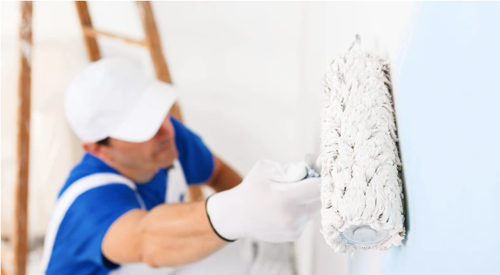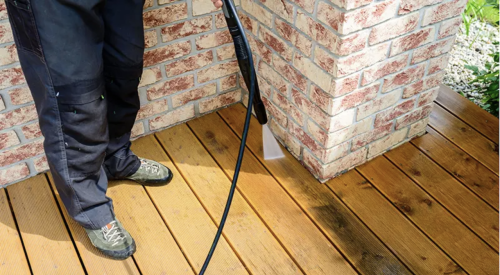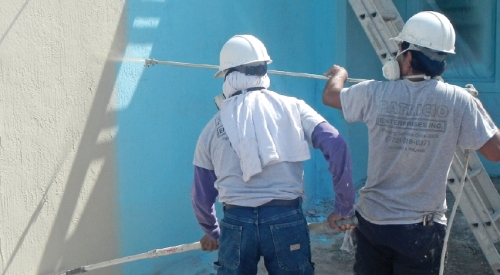|
Paint used on the exterior of a house differs from paint used on the inside. Exterior paint needs to withstand ultraviolet rays and water. Inside, the aesthetic is more important.
|
Frank Marsters can’t recall even one customer during his 33 years of custom home building who wanted the details of a paint or stain job, including the brand or number of coats used. Yet while the specifics might not matter to home buyers, Marsters knows that painting and staining are much more than a drop in the bucket to his clients — and to Marsters Co.’s credibility.
Because the outcome of painting and staining is so visible, Marsters refuses to let the bottom line dictate how he handles that aspect of his Missouri City, Texas-based business. “The economics are important,” he says, “but the real secret is to hire professional subcontractors. We hire subs like we ask our clients to hire builders. We do our homework.”
Doing the homework “can be a balancing act,” says Michele Neary, a manufacturer’s representative with United Gilsonite Laboratories, which makes paints and stains. “When a builder hires a contractor, he’s not only paying for the product, he’s paying for the time.”
Fast-drying products can minimize labor time and thus labor cost. “In the past, especially with polyurethane, builders found water-based was quick but not as durable, and oil-based was slow but more durable,” Neary says. Now, thanks to new resins that dry faster, “a builder can have both. Some resins dry in as little as two hours, which was unheard-of. That helps builders complete the job faster while maintaining quality.”
But don’t focus on speed so much that you sacrifice quality. “One of the big mistakes I see, particularly on exteriors, is the use of low-quality paints,” says Bob Cusumano, former president of the Painting and Decorating Contractors of America. “Instead of saving money, that approach winds up being more costly.”
As president of Coatings Consultants in Palm Beach Gardens, Fla., Cusumano investigates paint failures. He says two of the most common are peeling and discoloration. “I also see things as simple as mildewing or rust staining or as complicated as alkaline burn,” which occurs when paint breaks down because of contact with a highly alkaline surface. Cusumano says eliminating moisture can prevent alkaline burn. “If water is coming through cracks, patch the cracks. Or it might mean caulking the perimeter of openings.”
The key attributes of exterior and interior products differ. “On the exterior, use paints and stains that are as resistant as possible to the environment,” Cusumano says. Durability also is key because exterior paints and stains must stand up to elements such as ultraviolet light and water.
Inside, “you’re really staining and painting for the aesthetic quality,” Cusumano says. “The properties of the paints and stains don’t matter as much as long as they make a room look good.”
Paint and stain requirements also vary by region. In the Southeast, for instance, the products must resist mildew and extreme heat, while in the North, “many of the paints used can be applied at lower temperatures, extending the time of year when a contractor can apply them,” Cusumano notes. To combat mildew, “you can use latex paints because they have less of a tendency to mildew. Also, smooth and glossy surfaces tend to mildew less than rough, flat surfaces, which tend to hold moisture and dirt.”
Many manufacturers produce paints and stains regionally and tweak product formulas to suit regional needs. For example, a paint sold in a mildew-prone area will include additional mildewcide.
In general, top-of-the-line products “contain more solids, which provide a larger spread rate,” says Christopher Brazie, technical representative for Martin Senour Paints. “Most builders and contractors look at cost — ‘What’s my price per gallon?’ — without thinking about what they get for that price. We have some products that sell for more price-per-
gallon-wise, but you get a greater spreading range, so you purchase less, and your cost is the same, if not less.”
Harold Blumenfeld, president of Gateway Paint & Chemical Co., cites another drawback to painting on the cheap. “If you use a very inexpensive product, chances are you will need more of it to obtain the opacity you’re trying to get.” In addition, he says, paint lacking enough latex or acrylic latex won’t bind as long or withstand washing or scrubbing.
Blumenfeld says some builders also make the mistake of rushing a job. “Generally,” he adds, “builders tend to use better-quality products because while the product cost is not inconsequential, it’s far less than the labor costs involved.”
To avoid getting into a bind over time, cost and effectiveness, Cusumano says, builders should use crews of at least three or four. “If you pay a lead painter a certain amount an hour and have him with one journeyman who makes less, that’s a certain average an hour. If you have him with two people at one amount and three more at a lower one, the average is even lower. A one- or two-man crew doesn’t necessarily keep it lean and mean because the job could take twice as long.”
Mixing and matching people and tasks typically doesn’t work either, so let workers stick to jobs for which they are most qualified, advises Robert Rhea, president of Integrity Refinishing Coatings. “A lot of people use special people for special jobs,” he says. “Each job has a different task, and it’s a mistake to combine them.”
Surface Preparation
“You have to prepare a surface to accept a new coating,” Rhea notes. “It has to be cleaned and dusted, and old, bad paint has to be removed. If you hurry through that and paint on an unclean surface or on paint that’s coming off, all you’re doing is putting paint on top of paint that’s not adhering. It will come off in a matter of months. That doesn’t make you look very good.”
Stretching the last of the paint to complete the preparation also can compromise the entire job, Rhea warns. “We recommend against scrimping,” he says. “With many paints, you can add reducers and stretch them a bit, but if you don’t do preparation properly, everything else will fall apart.”
Cusumano recommends devising a plan of action at the get-go. “A standard of quality needs to be established between the painting contractor and the builder so there are no surprises,” he says. “A contractor needs to know what degree of surface preparation is expected in terms of appearance. We talk about painting from two standpoints — the need to protect the surface and, of course, to beautify.”
Planning also helps prevent callbacks, which increase costs, notes John Stauffer, technical director for The Rohm and Haas Paint Quality Institute. He says applying a primer or paint coat that’s too thin can ignite consumer dissatisfaction and that “broad areas, such as walls and ceilings, should be done in dead-flat finishes to ensure uniform appearance and easy touch-up.”
As Alex Campbell, assistant manager of technical services and support at manufacturer Samuel Cabot Inc., says, “Knowledge is key. A lot of mistakes we see can be avoided if builders had the knowledge.”
Useful online resources include the Web sites of the Paint Quality Institute (www.paintquality.com), the Forest Service’s Forest Products Laboratory (www.fpl.fs.fed.us) and the Painting and Decorating Contractors of America (www.pdca.com).
Priming is a key component of painting and staining. The Rohm and Haas Paint Quality Institute identifies several categories of primers:
These primers come in oil-based, latex and alcohol-based formulas. The oil-based and latex types employ binders especially suited for stain blocking and include special pigments that also help in this regard. The alcohol-based type uses shellac as the binder and provides maximum adhesion and stain blocking but should be used only in interiors unless for small areas such as wood knots.










